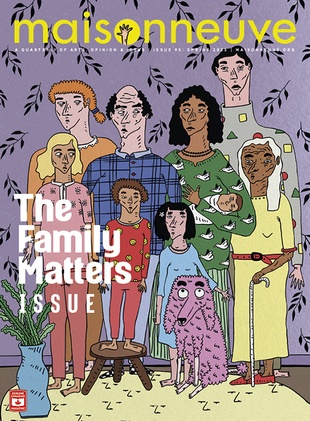The Fall 2021 Book Room
Fall reads from Jenny Boychuk, Carmella Gray-Cosgrove, Ian Williams and others.
Antonyms for Daughter
Jenny Boychuk’s debut poetry collection isn’t a ghost story. Or maybe it is. In Antonyms for Daughter (Véhicule Press), the poet grapples with losing her mother to addiction, guiding readers through the contradictory feelings that stem from her complicated grief. “I don’t know if I feel pain—” she admits in “Baby Fat.” “don’t we all eventually develop a taste for burnt toast?” Boychuk’s stanzas are both emotional and elegantly restrained, even as she struggles to untangle her own identity from her mother’s legacy (“There are certainties / I expected to inherit. […] A green felt coat— / but the bottles of white pills / sewn into its pockets, are they mine?”). In “Some Mornings, My Mother’s Voice In The Kitchen,” the speaker unexpectedly embodies Boychuk’s ghost-mother, pairing traumatic and soft anecdotes from her daughter’s childhood: “I once threw a shelf, aiming for you. / I once nursed you through a fever that boiled / over into Sunday.” Boychuk writes toward emancipation, capturing every unsettling facet of her loss, and ultimately provides her readers—especially the daughters among them—with solace.—Angelina Mazza
Disorientation: Being Black in the World
The global Black Lives Matter uprisings sparked by the murder of George Floyd and the ongoing social and economic fallout of the pandemic have left many of us in a state of turmoil. But for Canadian writer and poet Ian Williams, feelings of disorientation far precede the events of the past eighteen months. His latest book Disorientation: Being Black in the World (Random House Canada) is a collection of reflections from over the course of his life that became more pointed with the tumultuous events of 2020. Williams’s essays offer an unflinching personal look at the complexities of race and belonging. Early in the book, he writes: “I have made a contract with myself to speak the truth, speak only as myself, and to take the risk of speaking.” This promise, both to himself and to the reader, sets the stage for frank observations about the oppressive yet fragile nature of whiteness, being the only person of colour in the room, race relations between people of colour, and more. Williams shares that he is sometimes hesitant to weigh in during political discussions, feeling as if no amount of knowledge could ever be enough, but his writing brings a necessary perspective to urgent conversations.—Savannah Stewart
Ghost Forest
Grief hits in waves and continues long after the person—or place—being remembered is gone. The nuances of grief and how it can weave through generations are at the core of Pik-Shuen Fung’s debut novel, Ghost Forest (Strange Light). The unnamed narrator tells the story of her “astronaut family”—stretched between Hong Kong and Vancouver—and the struggles they face after their patriarch, from whom they’ve grown distant, dies. The scope of the novel is sweeping, touching on moments from the narrator’s life in Canada all the way back to her grandmother’s childhood in Hong Kong. Yet its structure is sparse—each chapter is a short vignette that reads like a poem, dainty but piercing. Fung gracefully expounds on the messiness of loss in ways that catch the reader off guard. In the moments after her father dies, the narrator returns home from the hospital and heats up bowls of Singapore noodles for her mother and sister in a sentimental passage that feels almost comical in its ordinariness. That is, until the narrator catches an image of her smiling father in the refracted light of the balcony window, and the dreamlike waves of grief wash over the scene once again.—Madalyn Howitt
Nowadays and Lonelier
Carmella Gray-Cosgrove’s first collection of short stories tugs at the threads that tie us to one another, exploring the unseen forces that bring us together. The stories in Nowadays and Lonelier (Arsenal Pulp Press) grapple with the effervescence of youth, the grip of economic precarity, and the messiness of love and lust. In the aftermath of a passionate but short-lived relationship, the narrator of “Fourth Floor Looking North” navigates a renoviction that turns a neighbour into a shell of herself after she’s also forced to leave her longtime home. Over morning coffees, the protagonist of “Whippits” listens to a boyfriend’s mother recount how her life changed after the city demolished parts of a once-thriving Black community in Vancouver. Gray-Cosgrove writes with a keen awareness of the social systems that shape opportunity, and how the realities of poverty irrevocably impact people and their environments.—Tobin Ng
This is How I Disappear
After a party, Clara gets home to her empty apartment. She goes to bed, but ends up staring at her ceiling. She makes herself some tea to relax and begins to sob while drinking it. Translated from the French by Brownyn Haslam and Aleshia Jensen, Mirion Malle’s graphic novel This is How I Disappear (Drawn & Quarterly) follows Clara as she struggles with her unfulfilling job, her relationships with her friends, and the emptiness growing inside of her. “The first time I felt like I wanted to die,” Clara shares, “I was probably, like, twelve? But that time doesn’t really count.” Malle offers a heartbreaking portrayal of depression, trauma and the shame that surrounds both. The black-and-white artwork helps readers experience Clara’s confusion, sadness and anxiety. We see her fail to connect with her therapist, break down alone in her kitchen, and attempt to write poetry on her phone at night. Still, she finally smiles on the last page. Malle’s work exudes compassion and gives us hope for moving through the darkness.—Sara Hashemi





